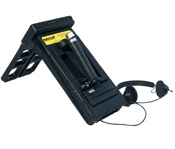Since the heli was canceled yesterday, I took some time to work on my taxes, but did get out for a quick run on the Pass at around noon. The wind was ripping pretty good, and I skied Twin Slides back down to the parking lot. My last pass run was about a week ago, and the skiing was better than I though it was going to be. I might try to ski in the park today.
 I had avalanche training for SAR last night at the King, and since our leader wasn’t feeling well, I volunteered to set it up. I didn’t want to make things too tough for my teammates and decided to have three exercises. I set up two drills, one with three buried transceivers and the other with two. I didn’t tell the crew how many were buried, cuz sometimes you just don’t know. The third and final drill involved using the Recco device to locate two victims.
I had avalanche training for SAR last night at the King, and since our leader wasn’t feeling well, I volunteered to set it up. I didn’t want to make things too tough for my teammates and decided to have three exercises. I set up two drills, one with three buried transceivers and the other with two. I didn’t tell the crew how many were buried, cuz sometimes you just don’t know. The third and final drill involved using the Recco device to locate two victims.
 This was my first time using the Recco, so it was great to get familiar with the unit. The search method is very similar to that of a regular avalanche transceiver, in that you zigzag down that avalanche path looking for a signal, while orienting the Recco device into different positions. Moving the Recco in a figure-eight pattern in front of you seemed to work best. When you receive a signal, you then orient the Recco in the position were the signal is the strongest. The searcher then takes a few steps in that direction, re-orients the Recco, and repeats. The Recco also has a volume dial that the user turns down as he/she gets closer and the signal gets louder. The grid-search method is then used to pin-point the victim.
This was my first time using the Recco, so it was great to get familiar with the unit. The search method is very similar to that of a regular avalanche transceiver, in that you zigzag down that avalanche path looking for a signal, while orienting the Recco device into different positions. Moving the Recco in a figure-eight pattern in front of you seemed to work best. When you receive a signal, you then orient the Recco in the position were the signal is the strongest. The searcher then takes a few steps in that direction, re-orients the Recco, and repeats. The Recco also has a volume dial that the user turns down as he/she gets closer and the signal gets louder. The grid-search method is then used to pin-point the victim.
 Now I must say that I think I learned more by just watching the crew use the device than I would have if I was just going though the motions. Some of the things that stood out were to keep the Recco unit pointed upward, and not directly a the snow…until the pin-point search of coarse. It seemed as though the range dropped considerably when the Recco was held below 90° to the slope. Also, I think that it is important to slow down a bit and remember to re-orient before proceeding further. When using an avalanche transceiver, especially digital ones, we tend to move rather quickly, where as with the Recco, I think slowing down a bit will only help in the long run.
Now I must say that I think I learned more by just watching the crew use the device than I would have if I was just going though the motions. Some of the things that stood out were to keep the Recco unit pointed upward, and not directly a the snow…until the pin-point search of coarse. It seemed as though the range dropped considerably when the Recco was held below 90° to the slope. Also, I think that it is important to slow down a bit and remember to re-orient before proceeding further. When using an avalanche transceiver, especially digital ones, we tend to move rather quickly, where as with the Recco, I think slowing down a bit will only help in the long run.
Anyway, it was nice to see the Recco in action and see a SAR training from the other end. Now I know why our board members know so much…they learn from our mistakes!
